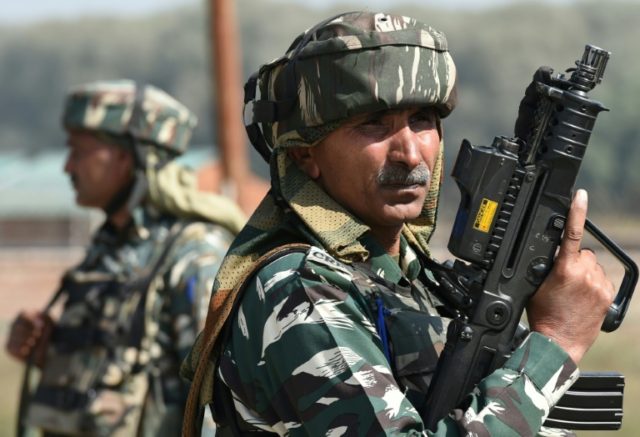India joined the world’s top military spenders last year, coming in fifth place after the United States, China, Saudi Arabia, and Russia, respectively, a defense budgets independent watchdog revealed in an analysis released Wednesday.
‘Tensions between China and many of its neighbors continue to drive the growth in military spending in Asia,” declared Siemon Wezeman, the senior researcher for the Arms and Military Expenditure (AMEX) program of the Stockholm International Peace Research Institute (SIPRI) that authored the report.
“The Indian government plans to expand, modernize and enhance the operational capability of its armed forces, motivated at least partially by tensions with China and Pakistan,” the assessment adds.
China and its ally Pakistan consider India to be their regional military and economic rival.
Shashank Joshi, a senior research fellow at the U.K.-based Royal United Services Institute, indicated to the South China Morning Post (SCMP) that India faced a mounting challenge in modernizing its military, noting:
Clearly, India’s relations with both Pakistan and China have deteriorated over the past decade, and particularly since 2016 or so. This has not had a dramatic impact on India’s level of spending, but it has led to specific investments.
The military spending assessment comes soon after Indian Prime Minister Narendra Modi joined Chinese President Xi Jinping in China for an “informal meeting” during which the leaders discussed ongoing disputes along their mutual border, among other issues.
Adam Ni, a researcher on China’s foreign and security policy at the Australian National University, told SCMP that the increase in India’s military was insufficient to match China’s, noting that Beijing’s defense spending, as presented by the watchdog, was a “massive underestimate.”
“India is doing what it can to improve its military to affect Beijing’s strategic calculus in favor of India. That is, to be able to impose more cost on Beijing in case of competition or conflict,” the expert noted.
An Indian official recently said that India is ready to face China on the battlefield if necessary.
Tensions with China have reportedly also driven U.S. ally Japan to step its military spending game up.
SCMP notes:
Although the report said Japan remained in eighth place for military spending, its defense outlays for the year starting April 1 were due to rise for a sixth straight year, going up by 1.3 percent to 5.19 trillion yen (US$45.76 billion), according to a budget breakdown published by its government last month.
Japan’s increases in defense spending represent a change in policy since the 2012 cut to the defense budget.
“Perceived threats from China and North Korea remain the most important factors in Japan’s security strategy,” SIPRI’s assessment said.
Primarily driven by the United States, global military spending reached $1.7 trillion, marking a “marginal increase of 1.1 percent in real terms from 2016,” the watchdog notes in a press release announcing its assessment.
“Continuing high world military expenditure is a cause for serious concern,” SIPRI chairman Jan Eliasson reportedly said as he released the report, adding that “it undermines the search for peaceful solutions to conflicts around the world.”
Together, the top five defense budgets — U.S., China, Saudi Arabia, Russia, and India — accounted for 60 percent of the total global military spending.
The SIPRI press release notes:
China’s military expenditure rose again in 2017, continuing an upward trend in spending that has lasted for more than two decades. Russia’s military spending fell for the first time since 1998, while spending by the United States remained constant for the second successive year.
….
The United States continues to have the highest military expenditure in the world. In 2017 the USA spent more on its military than the next seven highest-spending countries combined. At $610 billion, US military spending was unchanged between 2016 and 2017.
Dr. Aude Fleurant, the director of the research institute’s Arms and Military Expenditure (AMEX) program, indicated that the Trump administration had put the brakes on the historic drop in military spending that began under former U.S. President Barack Obama.
Various Pentagon officials argued that cuts to the U.S. defense budget, particularly those that came as part of the so-called sequestration agreement reached by the Republican-led Congress and Obama, reduced America’s military readiness.
Dr. Fleurant said:
The downward trend in US military spending that started in 2010 has come to an end. US military spending in 2018 is set to rise significantly to support increases in military personnel and the modernization of conventional and nuclear weapons.
SIPRI’s analysis echoes the most recent annual Jane’s Defence Budgets Report authored by prominent research firm IHS Markit, which also covers military spending in 2017.
IHS Markit placed India in third place after the U.S. and China.
The 2017 Global Firepower (GFP) index, which ranks the capabilities of the world’s militaries using factors beyond the budget, placed India in fourth place after the United States, Russia, and China, respectively.

COMMENTS
Please let us know if you're having issues with commenting.